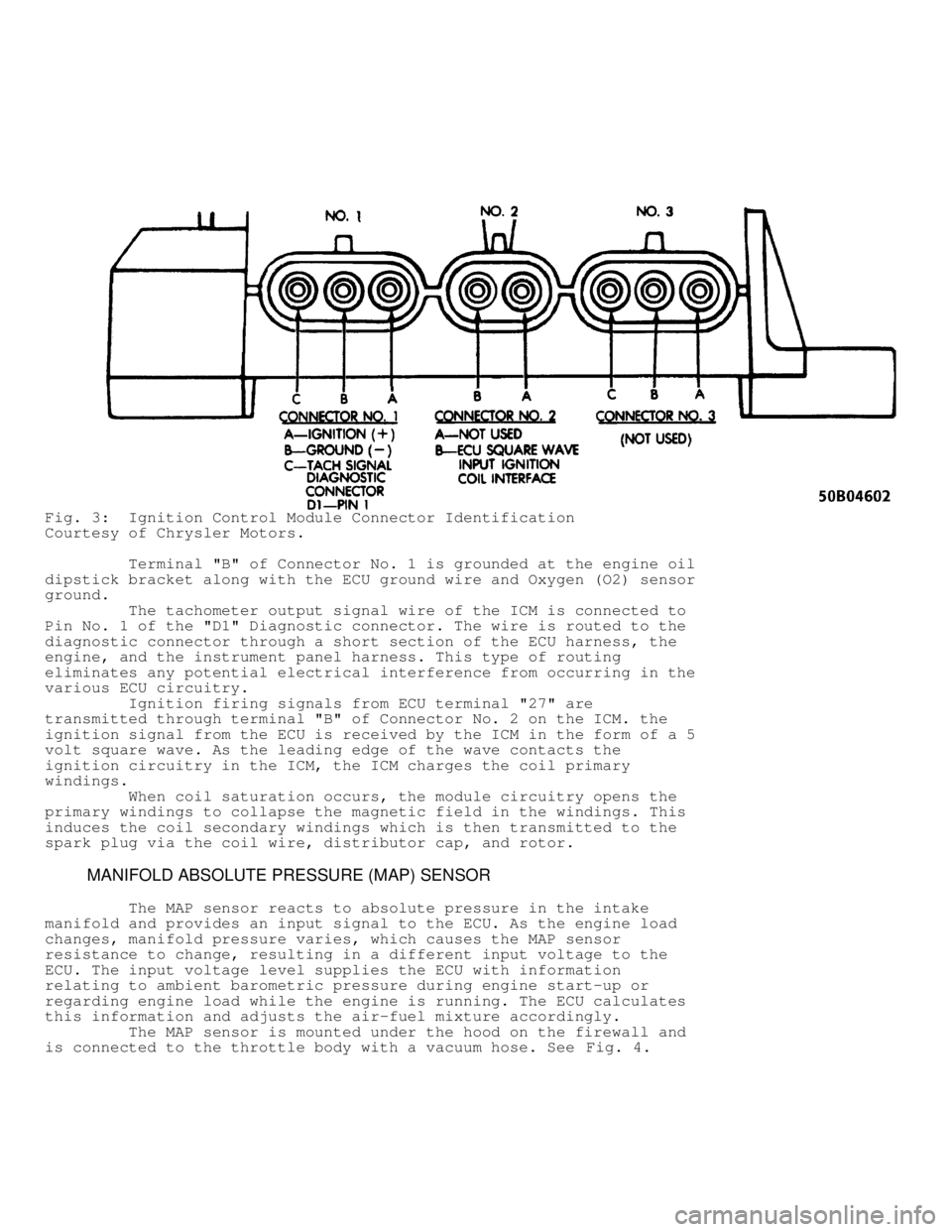Page 804 of 1378

Removal & Installation
Remove throttle body assembly as previously described.
Remove Torx head retaining screws. Remove throttle position sensor
from throttle shaft lever. To install, reverse removal procedure.
Adjust TPS after installation. See ADJUSTMENTS in this article.
MANIFOLD AIR/FUEL TEMPERATURE (MAT) SENSOR
Removal & Installation
Disconnect wire harness connector from MAT sensor. Remove
MAT sensor from intake manifold. To install, reverse removal
procedure. See Fig. 7.
MANIFOLD ABSOLUTE PRESSURE (MAP) SENSOR
Removal & Installation
Disconnect wire harness connector, vacuum hose, and
retaining nuts from MAP sensor. Remove sensor from firewall. To
install, reverse removal procedure.
ELECTRONIC CONTROL UNIT (ECU)
Removal & Installation
1) On Wrangler, remove passenger assist handle and glove box
assembly. Remove ECU bracket retaining nuts from engine compartment
side of firewall. Disconnect ECU wiring harness. Remove ECU from
bracket. To install, reverse removal procedure.
2) On all other models, remove retaining screws and bracket
that supports ECU above accelerator pedal. Remove ECU and disconnect
wiring harness. To install, reverse removal procedure.
EGR VALVE
Removal & Installation
Disconnect vacuum hose from EGR valve. Remove bolts which
hold EGR valve to intake manifold. Remove valve and discard gasket.
To install valve, reverse removal procedure. Always use new gasket.
See Fig. 7 .
TROUBLESHOOTING AND DIAGNOSIS
Page 811 of 1378
Fig. 14: TEST 3A: IGNITION ON: THROTTLE POSITION SENSOR (M/T)
Page 847 of 1378

\003
IG NIT IO N S YSTE M - 2 .5 L W /R EN IX E LE C TR O NIC IG NIT IO N
�
1988 J e ep C hero ke e
Distributors & Ignition Systems
JEEP RENIX ELECTRONIC IGNITION
2.5L TBI: Cherokee, Comanche, Wagoneer, Wrangler
DESCRIPTION
The Renix electronic ignition system consists of a solid-
state Ignition Control Module (ICM), a distributor, a Top Dead Center
(TDC) sensor, and an Electronic Control Unit (ECU).
OPERATION
IGNITION CONTROL MODULE (ICM)
The ignition control module is located in engine compartment,
just left of battery. The ICM consists of a solid-state ignition
circuit and an integrated ignition coil that can be removed and
serviced separately.
Electronic signals from the electronic control unit to the
ICM determine the amount of ignition timing or retard needed to meet
various engine requirements. The electronic control unit provides an
input signal to the ICM. The ICM has only 2 outputs: a tach signal to
the tachometer and diagnostic connector, and a high voltage signal
from the coil to the distributor cap.
TDC SENSOR
The TDC sensor senses TDC and BDC crankshaft positions as
well as engine RPM. Sensor is located on left rear side of engine and
is not adjustable. Sensor is secured by special shouldered bolts to
flywheel/drive plate housing.
TESTING
1) Disconnect ignition coil wire from center tower of
distributor cap. Using insulated pliers, hold coil wire about 1/2" (13
mm) away from engine block. Crank engine and check for spark between
wire and engine block.
2) If spark occurs, reconnect coil wire to distributor cap.
Remove spark plug wire from one spark plug. Using insulated pliers,
hold wire about 1/2" (13 mm) away from engine block.
3) Crank engine and check for spark between wire and engine
block. If spark occurs, check fuel system for problems. If no spark
occurs, check for a defective rotor, distributor cap, or spark plug
wires. Replace parts as necessary.
4) If rotor, cap and wires are okay, check for loose or
corroded connections at coil terminals. If necessary, clean terminals
and wires. Ensure wires are properly seated on coil terminals and not
wedged between coil body and terminal. If okay, go to next step.
5) Check for loose connectors at ICM or ECU. Verify that wire
connectors are firmly plugged into ICM and ECU. Also check for loose
ICM or ECU ground wire connections at oil dipstick bracket. Clean and
tighten if necessary.
6) Load test battery to ensure battery is fully charged.
Replace battery if necessary. If battery is okay, check voltage
between terminals "A" and "B" of ICM connector while cranking engine.
See Fig. 1 .
Page 849 of 1378

\003
IG NIT IO N S YSTE M - 4 .0 L W /S O LID S TA TE IG NIT IO N ( S SI)
�1 988 J e ep C hero ke e
DISTRIBUTORS & IGNITION SYSTEMS
Jeep Solid State Ignition
4.0L 6-Cylinder
DESCRIPTION
IGNITION SYSTEM GENERAL DESCRIPTION
The Solid State Ignition (SSI) system features a solid state
Ignition Control Module (ICM)/ignition coil assembly, Electronic
Control Unit (ECU), distributor and engine speed sensor. Other
components include the battery, ignition switch, starter solenoid,
spark plugs and wires, cap and rotor, resistance wire, by-pass wire
and a knock sensor. A sync pulse signal generator (stator) inputs the
firing order to the ECU.
Fig. 1: 4.0L 6-Cylinder Firing Order
IGNITION CONTROL MODULE (ICM)
The ignition control module is mounted to the ignition coil.
See Fig. 2 . Based on control system inputs, the ECU triggers the
ignition coil via the ignition control module. The ECU is able to
advance or retard ignition timing by controlling the ignition coil
through the ignition control module.
The ICM consists of a solid state ignition circuit, an
integrated ignition circuit and an integrated ignition coil that can
be removed and serviced separately if necessary.
Page 851 of 1378

Fig. 3: Ignition Control Module Connector Identification
Courtesy of Chrysler Motors.
Terminal "B" of Connector No. 1 is grounded at the engine oil
dipstick bracket along with the ECU ground wire and Oxygen (O2) sensor\
ground.
The tachometer output signal wire of the ICM is connected to
Pin No. 1 of the "D1" Diagnostic connector. The wire is routed to the
diagnostic connector through a short section of the ECU harness, the
engine, and the instrument panel harness. This type of routing
eliminates any potential electrical interference from occurring in the
various ECU circuitry.
Ignition firing signals from ECU terminal "27" are
transmitted through terminal "B" of Connector No. 2 on the ICM. the
ignition signal from the ECU is received by the ICM in the form of a 5
volt square wave. As the leading edge of the wave contacts the
ignition circuitry in the ICM, the ICM charges the coil primary
windings.
When coil saturation occurs, the module circuitry opens the
primary windings to collapse the magnetic field in the windings. This
induces the coil secondary windings which is then transmitted to the
spark plug via the coil wire, distributor cap, and rotor.
MANIFOLD ABSOLUTE PRESSURE (MAP) SENSOR
The MAP sensor reacts to absolute pressure in the intake
manifold and provides an input signal to the ECU. As the engine load
changes, manifold pressure varies, which causes the MAP sensor
resistance to change, resulting in a different input voltage to the
ECU. The input voltage level supplies the ECU with information
relating to ambient barometric pressure during engine start-up or
regarding engine load while the engine is running. The ECU calculates
this information and adjusts the air-fuel mixture accordingly.
The MAP sensor is mounted under the hood on the firewall and
is connected to the throttle body with a vacuum hose. See Fig. 4.
Page 852 of 1378
Fig. 4: View of Manifold Absolute Pressure (MAP) Sensor
Courtesy of Chrysler Motors.
COOLANT TEMPERATURE SENSOR (CTS)
The coolant temperature sensor is installed in the engine
water jacket on the left side of the engine. See Fig. 5. It provides
an input voltage to the ECU. As coolant temperatures vary, the Coolant
Temperature Sensor resistance changes, resulting in a different input
voltage to the ECU. The ECU calculates this information and adjusts
the following:
* Adjust fuel injector pulse width. Colder coolant
Page 853 of 1378
temperatures will result in longer injector pulse width
and richer air-fuel mixtures.
* Compensate for fuel condensation in the intake manifold.
* Control engine warm-up idle speed.
* Increase ignition advance when the coolant is cold.
* Energize the EGR valve solenoid, thus preventing the flow
of vacuum to the EGR valve.
Fig. 5: Location of Coolant Temperature Sensor (CTS)
Courtesy of Chrysler Motors.
MANIFOLD AIR TEMPERATURE (MAT) SENSOR
The Manifold Air Temperature (MAT) sensor is installed in the\
intake manifold with the sensor element extending into the air-fuel
Page 854 of 1378
stream See Fig. 6. The MAT sensor provides an input voltage to the
ECU. As the temperature of the air-fuel stream in the manifold varies,
resistance changes, resulting in a different input voltage to the ECU.
Fig. 6: Location of Manifold Air Temperature (MAT) Sensor
Courtesy of Chrysler Motors.
ENGINE SPEED SENSOR (CRANKSHAFT POSITION SENSOR - CPS)
The engine speed sensor is attached to the flywheel cover
housing and provides an input signal to the ECU relating to crankshaft
speed, angle, and position. See Fig. 7. The ECU converts crankshaft
speed input into engine RPM and converts crankshaft angle to piston